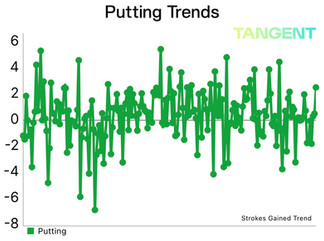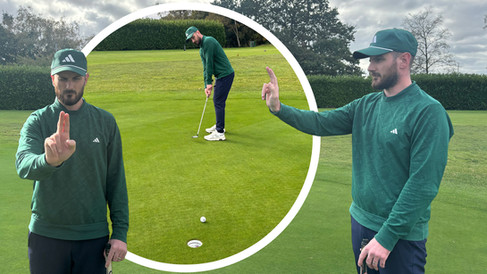My Honest Thoughts About the AimPoint Green Reading Method: Yes or No?
- keithfmuir
- Jul 2
- 6 min read
Updated: 3 days ago
AimPoint has become a bit of a dirty word amongst many golfers and golf pundits. It's often sighted as the main culprit for slow play, and the action of "straddling the line" makes some people almost apoplectic with rage. According to Mark Sweeney, the founder of AimPoint, most of what we see on TV and our local golf courses is players doing it wrong! It's worth having a listen to their podcast (here) and taking a look at their website (here) before making any further judgements. After an introduction from a friend, I went along to a class with Fintan Bonner (link) at the St Andrews Golf Academy to make up my own mind. Read on to hear my honest thoughts about the AimPoint green reading method and if I'm a Yes, or a No.

My current putting process
Tangent statistics prove that I am already a good putter, while the recent putter reviews and SAM fittings prove that my stroke is consistent and repeatable. So, if I want to improve at putting, it surely comes down to pace and line, which are ultimately determined by how well I read the green. Padraig Harrington will tell you that the biggest fault with most amateurs is that we under-read the break.
Right now, I read greens the "traditional" way, and I would say it is something I'm not particularly confident in. As I approach the green, I'm looking for any visual clues about slopes and how the green may be running. Does the land have an obvious slope? If I poured water on the green, how do I think it would run off? Where are the high and low points on the green? Mostly, I try to go with my first gut instinct of the line. I stand/squat behind the ball and try to visualise how it will run towards the hole. I'll try to determine the high side of the line and then walk halfway to the hole on the low side to assess how much slope there is. Sometimes, but not always, I will walk behind the hole and check the read from that angle too. Then I'll return to the ball, pick where I think the apex of the line is, choose a spot on that line that's 6" or so in front of the ball, align the club and myself to that spot and then hit the putt. That's a lot of steps on the green before hitting the ball, and I'll come back to that later.
Who you gonna believe, your feet or your lying eyes?
Having played a few times with my friend, and Tartan Tour player, Freddie Lawrence (link), I knew that he used AimPoint and asked him for an introduction. I was immediately attracted to the maths behind the system and the simplicity of how it's implemented into their system. As Mark Sweeney says, AimPoint Express was developed so a 7 year-old can implement it. I immediately ordered myself a digital level and got to practising what Freddie had shown me. Even at this basic level of knowledge, I've been surprised at how differently my feet read lines compared to my eyes. Freddie also recommended contacting Fintan as he is the most senior accredited AimPoint instructor in Scotland.
Lesson with Fintan Bonner
Having contacted Fintan, it just so happened that he was planning a small group clinic, so I immediately signed up to join. This was a two-hour session and was priced in line with other lessons at the academy. It would be inappropriate for me to detail all of the contents of that lesson, but I will give an overview.
The basics of AimPoint
AimPoint turns breaking putts into straight putts, not by defying the laws of physics, but by embracing them.
Assessing the slope. Assuming none of us suffer from any inner ear or balance issues, we are all capable of assessing slope with our feet. With a bit of practice, we can also become very accurate at it. Our body is an amazing tool. Use a digital level (using % slope) to check your assessment.
Find your aiming point using your fingers. This is where the instruction comes in - what way to use your hand, when to bend your elbow, etc. - but that's what you're paying the instructor for.
Every putt now becomes a straight putt to the aiming point, and, if you have correctly read the break and married that with the right pace, then the ball should fall.
Now, that is a very simplified account, and your lesson will be much more detailed. It will take you through setting up a calibration area with different slopes, how to use your digital level, what way to hold your hand and the different methods for short and long putts, where to stand when aiming, how to deal with double-breaking putts and how to alter your read for uphill and downhill lies.
Then, like all things with golf, you have to practice, practice and practice some more until you build trust in the system.
Pros and Cons of AimPoint
Speed: It's faster than the conventional method. There, I've said it, but I need to caveat it first! IF you implement AimPoint correctly, then it should be faster than traditional green reading. The problems stem from players not implementing it correctly, taking too long over the read or taking too many reads (front, back, beside the hole etc.). Some I've seen on TV are using a hybrid of AimPoint and traditional reading, suggesting they don't trust either. The full traditional read doesn't often get shown on TV, but when it does, the commentators usually say how diligent the player is being or how much effort and attention they are putting into the read. When they cover an AimPoint player, they very often blame them for slow play. It's highly likely these players have always been slow, with or without AimPoint.
Steps on the green: You should take fewer steps on the green using AimPoint than with the traditional method. You are only reading the putt from one direction. You don't need to pace around the hole looking for the high point or checking from behind the hole etc. I tried to find a visual representation of the number of steps taken in each method, but (surprisingly) I couldn't find anything. If you've got a 30' putt, that's about 10 paces to the hole, then paces behind for a look, paces to the side, then back to the ball. With AimPoint, you'll only walk to 10', then 20', then back to the ball. It should take considerably fewer steps.
You're standing on my line: Well, that's just poor etiquette by your playing partner. If you are at risk of encroaching on someone else's line, then you should take your read from the side. It will be just as accurate, and you won't get complaints.

What about all those steps around the hole: Every player steps around the hole when they collect their ball, but if you implement AimPoint correctly, you shouldn't need to read right at the hole. You are supposed to split the putt into thirds and take the reads from there. During the class, Fintan did take extra reads in the last third during our lesson, though. I asked him about that and mentioned the comments from the official podcast where they say they don't teach that. For Fintan, depending on the length of the final third, he will keep recommending you take some extra reads. I thought that was interesting, especially as it is different from what Mark Sweeney has said.

Linear vs Non-linear preferences: I think AimPoint works best for linear players. Those who see in straight lines rather than visualising the roll of the ball towards the hole. Most AimPointers you see will likely also use a line on their ball when aiming. I am a non-linear putter and don't like a line on the ball, although I could be persuaded if I saw better results with it. I prefer to pick a spot slightly in front of the ball and align my club to that spot before aligning my body to the club. Players who take an age over checking and moving the ball until the line is "just right" really frustrate me, and I don't want to join their ranks. In a recent podcast with Tony Write, Bruce Rearick suggested that those players who use a ball line most effectively don't have a line on their putter. I found that quite interesting, especially given how difficult it is to find putters without any alignment lines.
Thoughts and conclusion
AimPoint works, and it's easy to learn. While it's still early days for me and AimPoint, so far, I'm impressed. To answer my opening questions, it's a yes for me. The eureka moment was when I first used it to read a longer putt and found that my visual read was so far off relative to my AimPoint read. It takes time, but I'm learning to trust it and have been using it on the course as well as on the practice greens as I get back to playing post my recent injury layoff.
If you struggle with green reading, I would thoroughly recommend AimPoint. There's a good reason why so many of the top golfers use it. Just use it quickly and remember good etiquette!
EDIT: For an update on my putting performance since learning AimPoint, follow this link to my other, golf specific, site. https://www.theclubhouse.blog/p/has-aimpoint-improved-my-putting?r=68lv3g&utm_campaign=post&utm_medium=web






















Comments